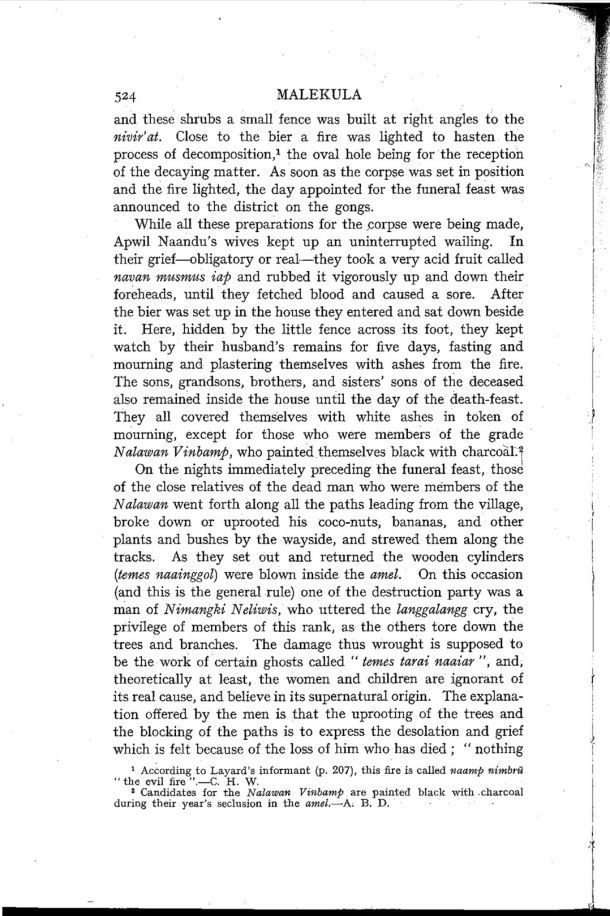|
|  [Note: this transcription was produced by an automatic OCR engine]
524 MALEKULA
and these shrubs a small fence was built at right angles to the
nivir’at. Close to the bier a ï¬Åre was lighted to hasten the
process of decomposition} the oval hole being for the reception
oi the decaying matter. As soon as the corpse was set in position
and the ï¬Åre lighted, the day appointed for the funeral feast was
announced to the district on the gongs.
While all these preparations for the corpse were being made,
Apwil Naandu‘s wives kept up an uninterrupted wailing. In
their grief—obligatory or real—they took a very acid fruit called
navzm musmus iap and rubbed it vigorously up and down their
foreheads, until they fetched blood and caused a sore. After
the bier was set up in the house they entered and sat down beside
it. Here, hidden by the little fence across its foot, they kept
watch by their husband’s remains for ï¬Åve days, fasting and
mourning and plastering themselves with ashes from the ï¬Åre.
The sons, grandsons, brothers, and sisters’ sons of the deceased
also remained inside the house until the day of the death-feast.
They all covered themselves with white ashes in token of
mourning, except for those who were members of the grade
N alawan Vinbamfi, who painted themselves black with charcoallg,
On the nights immediately preceding the funeral feast, those
of the close relatives of the dead man who were members of the
N alawzm went forth along all the paths leading from the village,
broke down or uprooted his coco-nuts, bananas, and other
plants and bushes by the wayside, and strewed them along the
tracks. As they set out and returned the wooden cylinders
(tamer nmzinggal) were blown inside the amzl. On this occasion
(and this is the general rule) one of the destruction party was a
man of Nimangki Neliwis, who uttered the langgahmgg cry, the
privilege of members of this rank, as the others tore down the
trees and branches, The damage thus wrought is supposed to
be the work of certain ghosts called “ temes mrai naaim â€ù, and,
theoretically at least, the women and children are ignorant of
its real cause, and believe in its supernatural origin. The explana-
tion offered by the men is that the uprooting of the trees and
the blocking of the paths is to express the desolation and grief
which is felt because of the loss oi hirn who has died ; “ nothing
1 According to La.yard’s informant (P4 207), this ï¬Åre is called mmmp m'mlmZ
"the evil ï¬Åre",—C. H, W.
' Candidates ior the Nalnu/an Vinbamp are painted black vith.charcoal
during their year’s seclusion in the amel.—-A4 B. D. - -
v
P
‘ ï¬Åi _ _v,_
— ' .
E
»
J,‘
.1
A 4
|